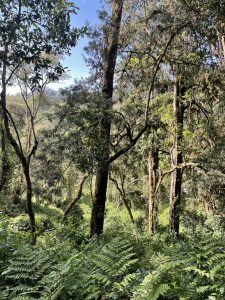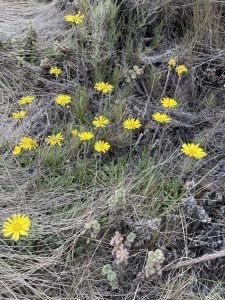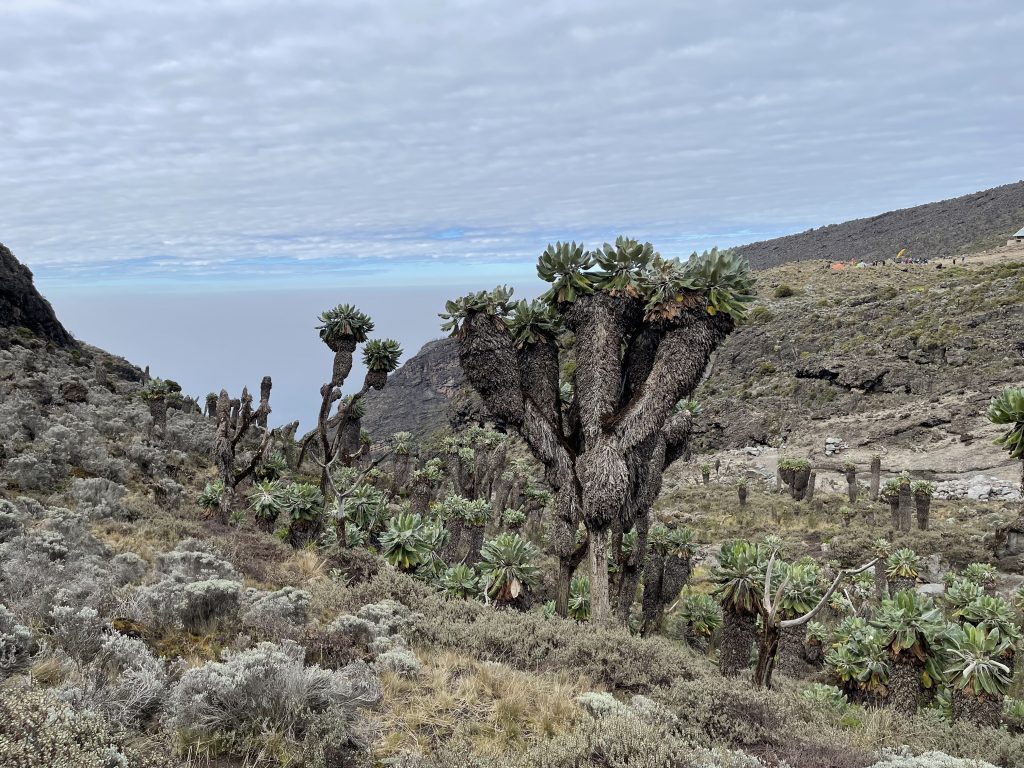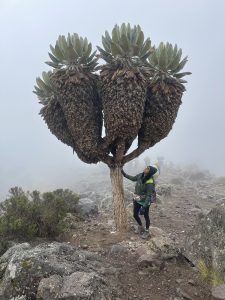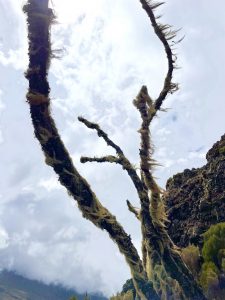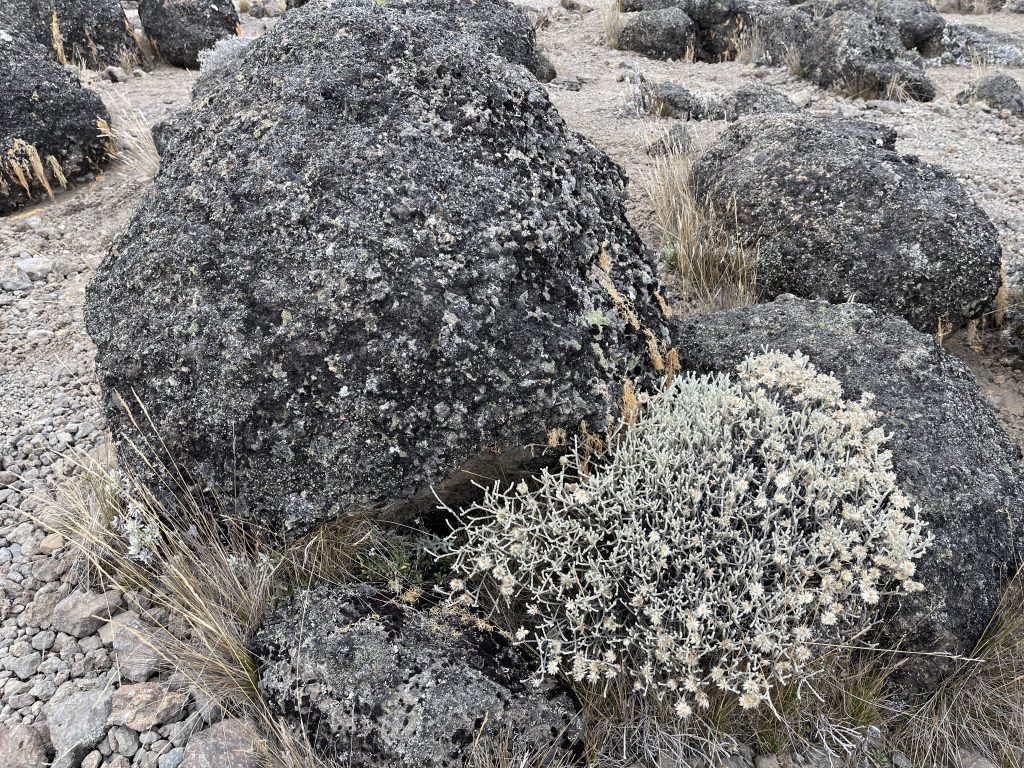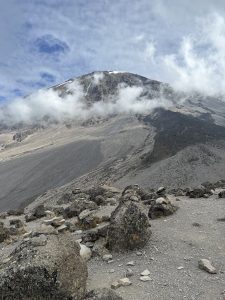
1. Cultivation Zone:
Alt. Range: 2,600 to 6,000 ft (792 to 1,800 m)
Temperature Range: Days: 70-90 F / 21-32 C
Nights: 40-60 F /4-15 C
As you leave Moshi to head to the park gates( Lemosho for us) to begin your climb, you’ll see plenty of human activity. From grazing of livestock, small farming operations, traffic and hustle and bustle of human life. This has changed the native vegetation, which would once have been scrub land and lowland forest. The southern side of the mountain has more rainfall and coupled with the fertile volcanic soil makes it ideal growing conditions.
2. Rain Forest Zone:
Alt. Range: 6,000 to 9,200 ft (1,800 to 2,800 m)
Temperature Range: Days: 70-90 F / 21-32 C
Nights: 40-60 F /4-15 C
Encircling the whole of the mountain is a montane or tropical rain forest. Dense and damp, this forest is home to many different bird and animal species. Due to the increase in human activity, it’s rare to see any big animals, but monkeys and birds can be spotted if you are lucky.
The trees are covered in ‘old man’s beard’, orchids grow on the branches of ancient trees. Black and white Colobus monkeys live in the treetops and sometimes there are troops of Baboons. We were lucky to see furry colobus monkeys swinging and eating on low branches. We were told though difficult to spot, small antelope, rodents and bush pigs make this their home.
3. Heath and Moorland Zone:
Alt. Range: 9,200 to 11,000 ft (2,800 to 3,350 m)
Temperature Range: Days: 50-80 F / 10-27 C
Nights: 30-60 F /(-1)-15 C
The forest seems to stop abruptly as you enter the heath and moorland zone, and suddenly you’ve got magnificent views. Characterized by the scrubby shrubs, giant heathers and tussok grasses, parts of this sometimes does look like a parts of Cumbria or Scottish highlands.
As you ascend, and average temperatures drop, you’ll see the giant lobelias and senecios. These plants have developed unique characteristics that allow them to thrive in the drastic temperature swings. As the senecios grow taller, their leaves die and stay on the plant, forming a fur-like insulation around the trunk. Lobelias close their leaves at night, covering their central core for warmth.
Very few animals live here. Small rodents make their home in tiny caves carved out of the volcanic rock. We spotted some striped mice. Depending on your route, you may spot antelopes or bush babies. We saw some paw prints that got us very excited.
4. Highland Alpine Desert:
Alt. Range: 13,200 to 16,500 ft (4,020 to 5,030 m)
Temperature Range: Days: Days: 10-60 F / (-12) -15 C
Nights:10-40 F /(-12)-4 C
Intense rays of the sun beat down during the day and at night it’s below freezing. There is very little water in this area, and only the hardiest plants can exist. It’s barren, arid and inhospitable. You’ll come across small hardy plants, very few flowers and the odd tussoky-grass.
The landscape is dominated by rugged rock formations and panoramic views. If you look you’ll spot mosses and lichens, which cover the rocks, avoiding the soil altogether. These are the plants that thrive in this barren environment.
5. Arctic Summit zone:
Alt. Range: 16,500 to 19,340 ft (5,030 to 5,895 m)
Temperature Range: Days: 10-40 F / (-12) -4 C
Nights: -15-20 F /(-26)-(-7) C
Also known as the Arctic zone, this area is dry, freezing cold at night and subject to intense sunshine during the day. With half the available oxygen as sea level, the area is dominated by huge glaciers, and large boulders. There is no resident animal or plant life, except for a few very hardy lichens, slow-growing and probably ancient.
It’s very cold here, with blustery winds and nighttime temperatures well below freezing. As you summit, there may be ice or snow, it’s bitterly cold, even at midday and the sun’s radiation is harsh.
Wear Sunscreen on any exposed parts of your body especially on your nose, carry lip balm and apply if and when you remember. The dry air will dehydrate you quickly, and you’ll need plenty of warm layers to keep your core temperature up.
Keep going …Pole Pole
